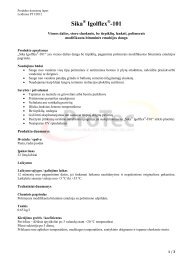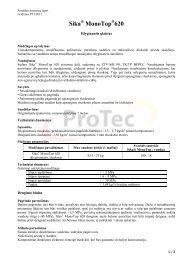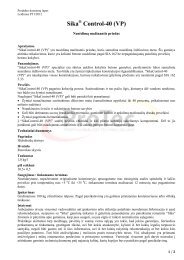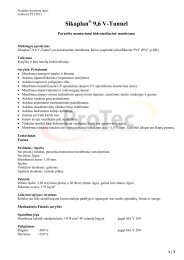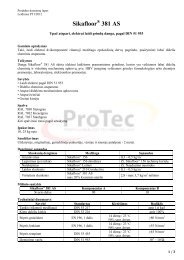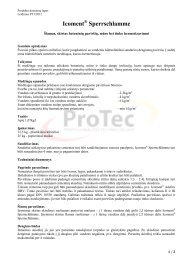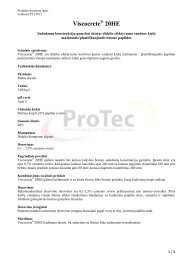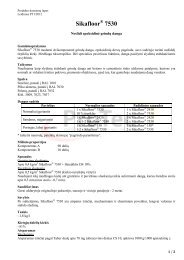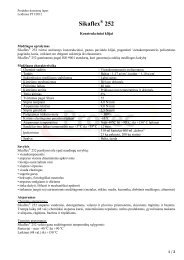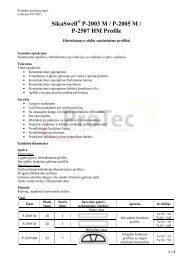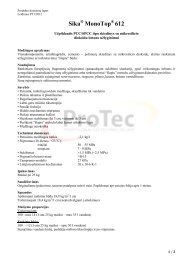Sikaflex Marine Handbook
Sikaflex® Marine Handbook - BlueMoment
Sikaflex® Marine Handbook - BlueMoment
- No tags were found...
Create successful ePaper yourself
Turn your PDF publications into a flip-book with our unique Google optimized e-Paper software.
Instructions forCaulking Teak DecksApplication of<strong>Sikaflex</strong> ® - 290DCBefore any work commences ensurethe temperature of the wood does notexceed 25°C.In addition, the operating temperatureduring application should be constantor falling and ideally within the range of+5°C and +25°C.Apply <strong>Sikaflex</strong> ® -290 DC ensuring air isprevented from entering the seam byplacing the tip of the nozzle againstthe bottom and keeping the gun at anangle of 60°–90°. Always use a handgun or a piston-driven airgun.Continue to pull the nozzle along theseam so that the joint is filled behindthe nozzle always ensuring a constantmotion is maintained. (Figs. C,D)After application of <strong>Sikaflex</strong> ® -290 DCand before skinning occurs, tool theexcess material from the surface of thedeck using a slightly flexible spatula at45°. This ensures complete filling ofthe seam.Protect the caulked joints from rainand direct sunlight for a period of atleast 8 hours. Do not use excessmaterial from the spatula for fillingseams.<strong>Sikaflex</strong> ® -290 DC is ready for sandingafter 7 days.Important: Please refer to the current Sika Technical DataSheets and Safety Data Sheets obtainable through Sika ortheir local distributor.The Sanding ProcessFollowing 7 days curing the deck isready for sanding. Prior to that, however,excess cured <strong>Sikaflex</strong> ® -290 DCshould be removed with a sharpchisel or knife.This procedure will avoid excess pullon the edges of the seams during thesubsequent sanding operation. Foreffective sanding results use anindustrial sander. It is recommendedto begin with a medium (80)progressing to a 120 grit or finer.Suitable sanders are beltsanders, flatplate sanders or elastically suspendedsanders. Sanding should be along thedirection of the seams.The Finishing TouchAlthough we do not recommendthe application of a finish to theexterior teak deck, many boatowners prefer to apply a lacquerfinish to the deck after sanding.Generally great care should betaken as finishes contain solventsor plasticisers which can adverselyaffect the cured <strong>Sikaflex</strong> ® -290 DCor the drying of the lacquer.The following criteria shouldalways be taken into consideration:Never apply the lacquer finish touncured <strong>Sikaflex</strong> ® -290 DC.Waiting time of at least one monthbefore application of the finish isrecommended.The compatibility of the lacquershould be evaluated on a smallsample area of the teak deck beforeapplication.Rigid lacquers have a negativeeffect on the elasticity of the jointand may crack or cause loss ofadhesion of the <strong>Sikaflex</strong> ® -290 DCfrom the teak planks.MaintenanceIt is important to wet and rinsethe deck regularly with freshwater in order to prevent dryingout. In warm climates thisprocedure should be carried out ona daily basis. The occasional use ofa mild detergent (natural liquidsoap) diluted in water should bekept to a minimum. Bleach andaggressive chemical cleaners shouldnot be used.NotePrefabricated teak decks oftenconsist of a multilayer construction,e.g. they are made of wood ontowhich a fine layer of teak isbonded. The base wood mightconsist of various wood qualities;the pores in the “wood” aredifferent in structure and size,therefore the caulking compound isnot always in a position to expelthe air pockets from the poresduring caulking. As a result smallbubbles within the joint maysurface during caulking. To avoidthe development of these “air”bubbles, we recommend toolingthe joints using a smooth, slightlyflexible spatula at an angle of 45°,expelling air from the pores andallowing a perfect joint to developduring cure.Fig. CFig. D7



